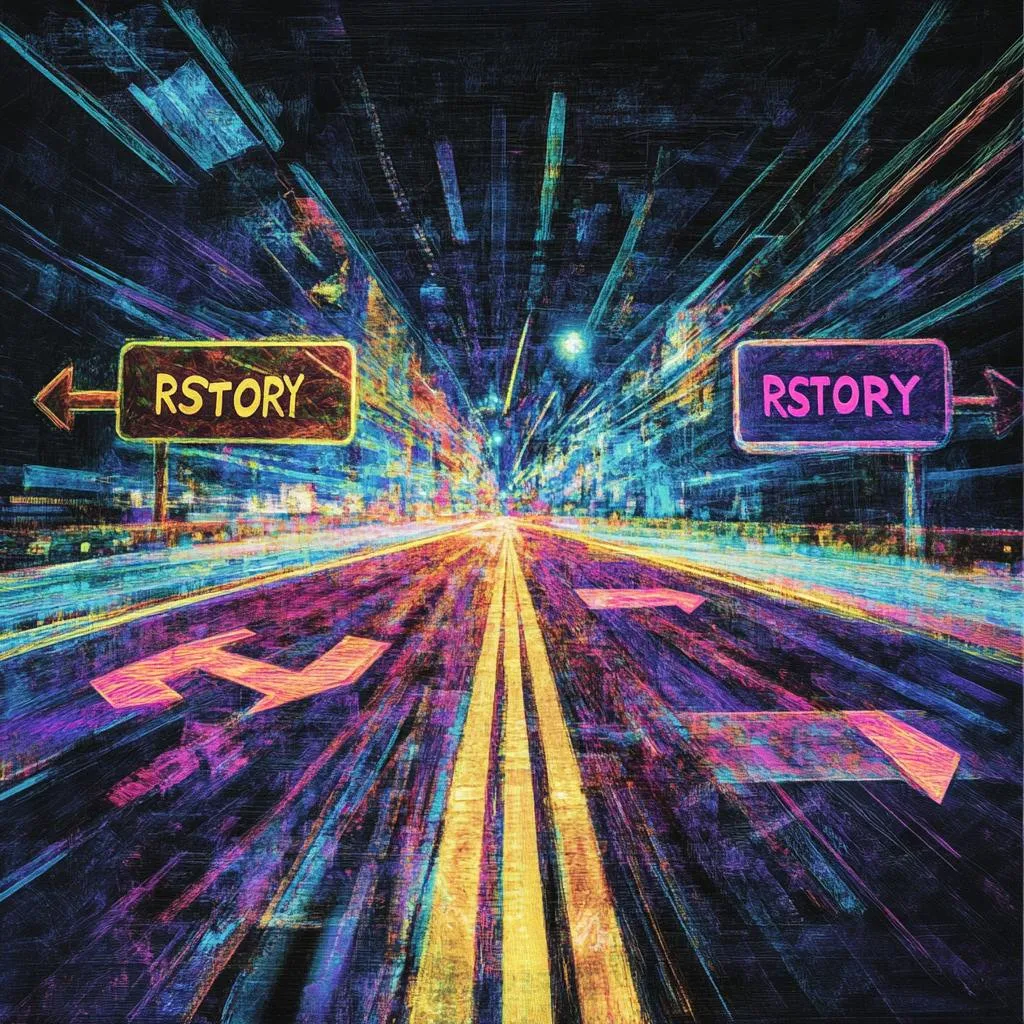
The above image was made by @amberjyang with Midjourney using a variation of the prompt 'different roads going left and right, , arrows pointing different directions, road disappears, with the words "RSTORY" on the road, holographic prism.'
As a planning exercise, I recently came up with four scenarios describing where my Rstory token might go in the future. These scenarios explore the influence that two variables might have on the project's growth trajectory. These variables are crypto community participation and mainstream participation. I plan to develop these sketches further in another document.
Low crypto community participation and low mainstream participation
A small group of outliers keep the fringe project alive.
The crypto community had bigger and more profitable ventures to develop. Average people proved unwilling to create their own crypto wallets. By the end of 2025, only a few hundred wallets held the token. It was 2027 before the project reached a thousand users.
Despite low rates of participation, the Rstory network filled a niche. It showcased some of the creativity that was getting pushed out of the centralized web.
This is probably the most likely scenario.
Low crypto community participation and high mainstream participation
Publishers get on board, led by independent media.
While the crypto community largely ignored Rstory, the project's media product access model attracted large numbers of average people eager to access high quality digital content more simply and affordably. One by one, independent media outlets began adopting Rstory to get around censorship and explore the new revenue model. Then, in 2026, a major streaming platform began making its offerings available to Rstory holders as well as paying customers. The project's popularity exploded.
Through all of this, Rstory's tokenomics were wildly unpredictable. Volatility was high and it was almost as if no one at all was managing Rstory's token market presence.
High crypto community participation and low mainstream participation
The token takes off, but no one knows what it's for.
Intrigued by the project's model, blockchain developers created a wide variety of Rstory dapps. Some of these became moderately popular, attracting thousands of users. The token's market presence was small but stable.
Mainstream adoption was low, partly because the project never managed to communicate effectively with average people. At the same time, the people Rstory did attract were the kinds of people that the mainstream actively suppressed. The project provided a refuge for this group yet never achieved widespread popularity.
High crypto community participation and high mainstream participation
Legacy economy instabilities drive many to use Rstory.
A perfect storm of political, social, and economic forces turned Rstory from a micro token into a sensation. Alternative media adopted the tech to skirt censorship. Then a major news service integrated the token in a desperate bid to generate new revenue. Soon, Rstory was replacing tickets at concerts and other events.
This rapid growth produced high volatility and a series of conflicts within the community for control over the direction of the project. These conflicts were ultimately resolved by creating better methods of decentralized governance.
Read Free Mind Gazette on Substack
Read my novels:
- Small Gods of Time Travel is available as a web book on IPFS and as a 41 piece Tezos NFT collection on Objkt.
- The Paradise Anomaly is available in print via Blurb and for Kindle on Amazon.
- Psychic Avalanche is available in print via Blurb and for Kindle on Amazon.
- One Man Embassy is available in print via Blurb and for Kindle on Amazon.
- Flying Saucer Shenanigans is available in print via Blurb and for Kindle on Amazon.
- Rainbow Lullaby is available in print via Blurb and for Kindle on Amazon.
- The Ostermann Method is available in print via Blurb and for Kindle on Amazon.
- Blue Dragon Mississippi is available in print via Blurb and for Kindle on Amazon.
See my NFTs:
- Small Gods of Time Travel is a 41 piece Tezos NFT collection on Objkt that goes with my book by the same name.
- History and the Machine is a 20 piece Tezos NFT collection on Objkt based on my series of oil paintings of interesting people from history.
- Artifacts of Mind Control is a 15 piece Tezos NFT collection on Objkt based on declassified CIA documents from the MKULTRA program.